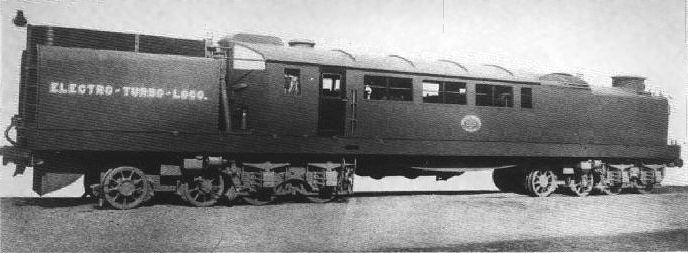The Reid-Ramsey Turbine-Electric was the first turbine loco to be built in the UK. The year was 1910, and the builder the North British Locomotive Company.
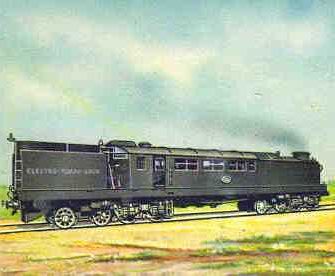
|
| A picture of the Reid-Ramsey. This is pretty obviously taken from the photograph above.
The locomotive carried a conventional loco-type boiler with superheating, feeding an impulse turbine running at 3000rpm. This was directly coupled to a dynamo that produced between 200 and 600 Volts DC. This energised four 275 HP series-wound traction motors, built directly on the axles of the larger wheels visible on the diagram below. It was therefore an expression of the "power station on wheels" philosophy.
The turbine-generator assembly was installed in the central section between the boiler and condenser. Both vacuum and Westinghouse compressed air brakes were fitted.
|
The condenser was of the ejector type, in which steam is condensed by direct contact with a spray of cold water, rather than the sort used in ships where the circulating water, being saline, must be kept separate. Steam turbines do not require internal lubrication (the shaft bearings do, of course, but these are not in direct contact with the steam) so the condensed water was oil-free and could be pumped back into the boiler. Water was handled by centrifugal pumps driven by auxiliary turbines.
Operation was thus. Circulating water was pumped from the tanks flanking the boiler into the ejector condenser. Mixed with the water from the condensed exhaust steam, it entered the hotwell. From here a second pump delivered it to the cooling tubes at the the front of the locomotive, and from them it was returned to the water tanks.
The condenser, the fitting of which was motivated by the desire to create efficient exhaust conditions for the turbines rather than conserving water, meant that a conventional blastpipe to create draught was impractical. An auxiliary turbine drove a fan in the cooler which impelled air through the cooling tubes, and according to a French journal (p317) part of this heated air was directed into the firebox. This implies a closed firebox working under positive pressure, which would have made firing very difficult. It would have been necessary to stop the condenser/draught fan every time the firebox doors were opened, and if you forgot flames would presumably have gushed out of the firedoor.
Total weight was 132 tonnes, with 89 tonnes available for adhesion; this seems like an unimpressive proportion to me, and was obviously a result of the 4-4-0 + 4-4-0 configuration chosen. Were the four non-driving axles really required? A 2-6-0 + 2-6-0 version would have put more adhesive weight on the track, but would have required six electric motors or some form of coupling between the axles. Contemporary opinion (in The Engineer) was that a steam-electric locomotive was already too complicated and expensive.
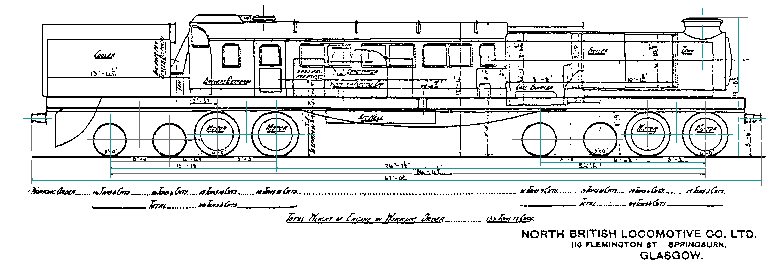
Above: The Reid-Ramsey Turbine-Electric. The front is at the left; it was a cabforward- or rather coolerforward- configuration.
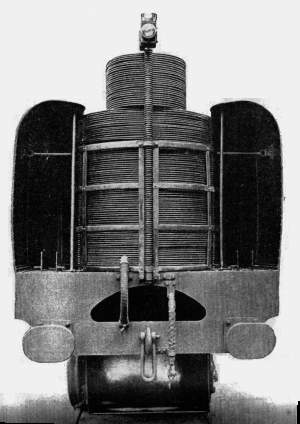
|
| The front of the Reid-Ramsey. This mass of piping is not the condenser- it is the cooler for the water used in the condenser.
Note large spaces at each side of the cooler tubing for the entry of cooling air, and the air scoop under the buffer beam.
|
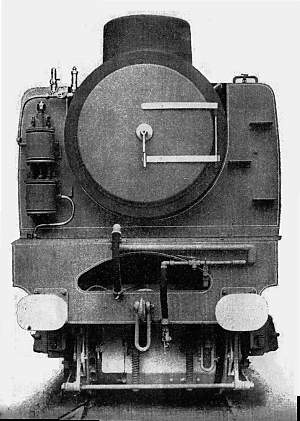
|
| The back of the Reid-Ramsey.
That is one large-diameter chimney. Why, I wonder? Was it something to do with the fan-induced blast for the boiler?
Westinghouse pump on the left.
These two images and supplementary information on this locomotive most kindly provided by Haruyuki Makishima
|
So- it all sounds very sensible, but how well did it actually work? Information is in very short supply. The British journal The Engineer for July 8, 1910, says: "The engine... has undergone certain tests on the works sidings independently, and also with a load of railway wagons attached. ...it has recently undergone its preliminary trial on the main lines of the Caledonian and North British Railways, with a saloon carriage attached."
These were clearly early days in the testing, and no further information on performance has so far emerged. I suspect that there were a lot of teething troubles.
The Reid-Ramsey cannot have been a smashing success as it was dismantled and rebuilt in 1924 using geared drive from two turbines, one per bogie: see The Reid-McLeod Turbine Locomotive
THE CONDENSER
For some time this page has suggested that the Reid-Ramsey locomotive may have been fitted with a rotating evaporative condenser. It is now clear that this was not the case. Such a condenser was fitted to the Armstrong-Whitworth Turbine Locomotive, and the information that used to be on this page can now be found there.
My apologies if I have misled anyone attempting to build their own steam-turbine locomotive.
HUGH REID: BIOGRAPHY
The Reid in Reid-Ramsey was Hugh Reid, the son of James Reid. He was born in Manchester on 9 February 1860.
In 1863 James Reid returned to Scotland to manage Neilson & Co. In 1893 he was joined by his four sons, including Hugh. On the death of James in 1894 Hugh became senior partner of the firm which in 1903 became part of the North British Locomotive Company, of which he became Deputy Chairman and Chief Managing Director, giving him the opportunity to pursue unconventional designs. Hugh received the freedom of the City of Glasgow in 1917 and was created a baronet in 1922. He died in Glasgow on 7 July 1935.







